Abstract
In this study, it is aimed to analysis of the economic efficiency of the small-scale coastal fishing activities operating on the Eastern Mediterranean coast of Turkey. In this context, face-to-face surveys were conducted with small-scale fishermen during the 2016-2017 fishing season and so these fisherman’s input usage, total revenue structures and socio-economic and demographic characteristics were determined. Data Envelopment Analysis method was applied to determine the economic efficiency levels of small-scale fisheries and extreme levels of input use was demonstrated. In addition, a Tobit Regression Model was applied to detect the factors causing the inefficiency of these small-scale fishers. The results of the analysis reveal that the average economic efficiency levels of the small-scale fishermen operating in the research area under the variable return to scale are 0.64. According to the results, it is possible to realize the same output performance when the fishers’ use of inputs is reduced by 36.1%. The main inputs leading to inefficiency in the output performance of small-scale fishers are determined as vessel maintenance expenditures (15.4%), fishing gear repair or purchase expenditures (12.3%) and labour costs (12%). In addition, Tobit Analysis was applied to investigate the relationship between the economic efficiency results and the socio-economic and demographic situation of small-scale fishermen. According to this, household size, working hours and vessel ownership factors causes economic inefficiency on the focused fishermen.
DOI: 10.30682/nm1804f
Levent Sangün*, Osman I˙nanç Güney*, Ali Berk**
* University of Çukurova, Vocational School of Adana, Turkey.
** Ministry of Food, Agriculture and Livestock, GTHB, General Directorate of Agriculture Reform, Ankara, Turkey.
Corresponding author: inancguney@gmail.com.
1. Introduction
Fisheries has historically been one of the main activities of the communities because of its contribution to the public economies and ability to meet nutritional requirements. Fishing sector is still important for the modern world, with providing food and sustaining income and employment, especially to the developing countries. Besides, fisheries provide the raw material that will be used by other economic activities of the coastal areas to create added value: processing, wholesaling, retailing, catering, hotel and restaurant services etc. (Malorgio et al., 2017). Improvements in economic performances, ongoing global population growth and changes on eating habits effect the composition and structure of food demand and the demand for seafood. For many developing communities, this demand mainly met by local food production systems. In this direction, while important developments in fisheries have been experienced like industrialization and modernization, artisanal techniques like small-scale fisheries (SSFs) are still very important especially at the rural coastal zones of the developing countries (Allison, 2011; Béné et al., 2007).
Characteristics of SSFs can be defined as; utilizing relatively small amount of capital and energy, smaller fishing vessels (less than 12 meters), making short fishing trips close to coasts and mainly meet the demand for local consumption. SSFs are generally identified by the use of a large number of boats of low tonnage, extremely diversified and selective low-impact fishing gear targeting a wide variety of species. They usually require small capital investment as opposed to industrial fishing, generate income and significantly contribute to food security, especially to rural coastal communities that greatly rely on this activity. SSFs is a typically part of a livelihood for the rural coastal zones, operate at widely different organizational levels ranging from self-employed single operations to informal micro-enterprises and most of these fishermen are considered at a low welfare standard of living. Small-scale fishers are prone to very high risk of vulnerability which are closely related to their fishing activity and the type of livelihood associated with it (Béné et al., 2007; Sudarmo et al., 2015; Guyadera et al., 2012; FAO, 2015).
Although the presence of SSFs activities contributes employment opportunities and generates local revenue, compared to commercial fisheries it has some problems like low investments, the lack of innovation, the smallness of enterprises, the weak market position, the fragmentation of the production, the difficulty to comply with sanitary and safety standards, the low level of education and economic freedom (Sudarmo et al., 2015, Malorgio et al., 2017).
SSFs are especially important for the developing countries and over 90% fishery workers in developing countries are working as small-scaled operators. The importance of SSFs in developing countries is mainly concerns on wealth creation, poverty alleviation and food security (Mauthe et al., 2013). FAO Advisory Committee on Fisheries Research (ACFR) Working Group on Small-Scale Fisheries (SSFs) also stated that «small-scale fisheries make an important contribution to nutrition, food security, sustainable livelihoods and poverty alleviation, especially in developing countries» (Malorgio et al., 2017).
SSFs also play a particularly important role in Mediterranean region despite the lack of official statistical information (Mulazzani et al., 2017). They represent more than 80% of total Mediterranean and 70% of Euro Mediterranean region’s vessel fleets (Sauzade et al., 2013; Naji, 2013). Among the Mediterranean countries four countries, Greece (17,355 boats), Italy (13,421 boats), Tunisia (11,326 boats) and Turkey (7,992 boats), has the largest small-scale fishing fleets at national level. The importance of SSFs and their role as a contributor to social cohesion, poverty alleviation, food and nutrition security, and economy growth are increasingly being recognized, although fairly unknown in the Mediterranean (Farrugio, 2013).
In Turkey, most of the Turkish fishermen are operating as small-scale fishers and about 85% of the Turkish fleet is composed of small vessels mostly the ones operating at the Mediterranean cost (Farrugio, 2013; FAO, 2015). SSFs is a very important source of livelihood for Turkish fishers especially for the coasts that cannot benefit well from international tourism and industrial activities. Most small-scale fishing vessels use basic gear, such as trammel nets and longlines. These small boats are operated by a mix of professional (i.e. full-time), subsistence (i.e. part-time) and recreational fishers. The production is generally sold fresh in local markets or directly to private consumers or restaurants in Turkey (FAO, 2015).
Yumurtalık and Karataş towns, where the research was carried out, are located on the Eastern Mediterranean coast of Turkey, within the boundaries of Adana province. This coastal zone is poor in benefiting from international tourism and industrial activities and primary income sources of the locals are agriculture and fishing. And the fishing activities are mainly operating by small-scale fishers. Yumurtalık and Karataş coastal zones hosts important coastal lagoons separated or connected with the Mediterranean as it is important and common for many SSFs operating coastal zones. Coastal lagoons, and also delta rivers, are hence hubs for the development of small-scale fisheries due to the high biodiversity and productivity of this areas and their proximity with locations and sites of relevance to fishermen (FAO, 2015).
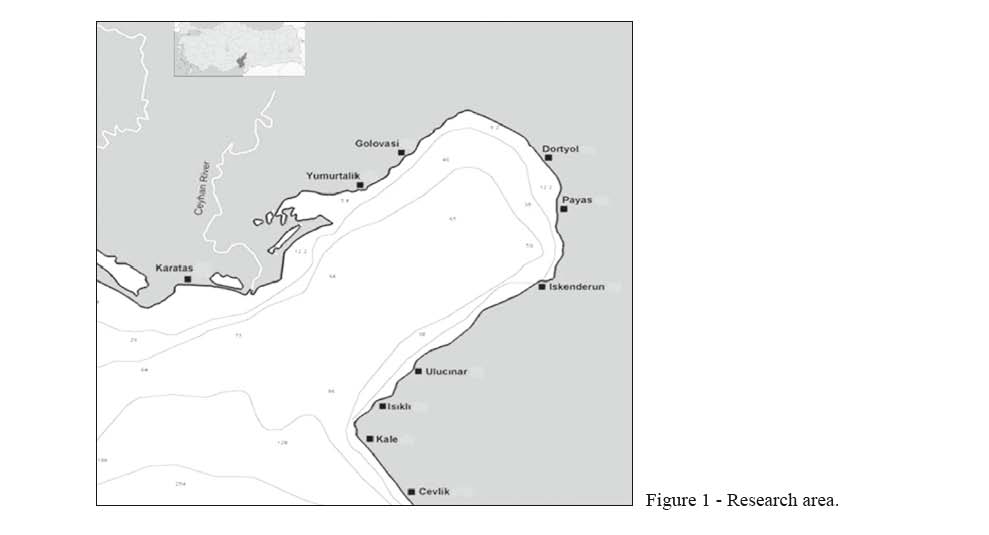
In the research area, actively 150 SSFs are operating and they are carrying out their activities whole year with different techniques. SSFs are utilizing gillnets and trammel net throughout the year and longline, encircling gillnets and pelagic gillnet in certain periods of the year. The most common seafood species caught by SSFs operating in the area are as fallows; Sparus aurata (Linnaeus, 1758), Labrax labrax (Linnaeus, 1758), Solea solea (Linnaeus, 1758), Pagellus erythrinus (Linnaeus, 1758), Pomatomus saltatrix (Linnaeus, 1766), Mugil cephalus (Linnaeus, 1758), and Sepia officinalis (Linnaeus, 1758).
Despite the recognition of the significant contributions of SSFs, the position and how they fit into the multiple activities of the coastal economies are poorly understood by the communities (Malorgio et al., 2017). Due to the neglect on small-scale fisheries topic by scientists and decision makers at national and super national levels, underestimation and underappreciation of social and economic value of the contribution of this fishing activity is emerging (Guyadera et al., 2012). Thus, this study aims to reveal the fishing performance of the SSFs operating at the east Mediterranean coast of Turkey in terms of economic value which directly effects their household income level and living standards as the main source of their livelihoods. In this context factors constitute and effect fishing revenues and expenditures of small-scale fishers were analysed.
2. Material and Method
2.1. Material
Main material of the study is the primary data obtained by questionnaire applied to small-scale fishermen operating at the Yumurtalık and Karataş towns which are located at Eastern Mediterranean coast of Turkey.
Face-to-face surveys were conducted with small-scale fishermen located at the fishing shelters in Gölavası, Haylazlı, Avluk towns and center of the Yumurtalık and Karataş towns. 64 Small Scale coastal fishermen (54.7% from the Karataş and 45.3% from the Yumurtalık) were surveyed and the surveys were managed throughout the 2016-2017 fishing season. The Fisheries Survey, which provides the basic material for the analyzes, was designed by the authors to obtain data on 3 fields. These are the variable costs incurred by the fishermen, the products and revenues obtained from the fishing activities, and the socio-economic and demographic structures of the focused fishermen.
2.2. Method
Efficiency is defined in a relative sense as the distance between observed input–output combinations and the best-practice frontier. The best-practice frontier represents the maximum output attainable from each input level (Ceyhan and Gene, 2014). Economic efficiency refers to the optimum combination of inputs to achieve maximum output at minimum input usage (Ceyhan, 2017). Efficiency measurements are typically implemented by either parametric or nonparametric models recently. In this study, Data Envelopment Analysis (DEA) which is a well-known and commonly used non-parametric production frontier estimation technique based on linear programming was used to estimate productive efficiency measures (Alemdar and Işık, 2008). Early mathematical form of the DEA methods was developed by Charnes et al. (1978), named as CCR model based on the works of Farrell et al. (1957), (Alemdar and Işık, 2008). The envelopment in CCR is constant returns to scale meaning that a proportional increase in inputs results in a proportionate increase in outputs (Toloo and Nalchigar, 2009). In 1984, Banker et al. developed the BBC model to account for the variable returns to scale to estimate the pure economic efficiency of decision making units with reference to the efficient frontier. For N Decision Making Units (DMU), each producing M outputs by using K different inputs an input-oriented BBC model is given by Coelli et al 2005 (Alemdar and Işık, 2008).
Min 0,λ θ subject to
yi + Y λ ≥ 0
θ Xi – X λ ≥ 0
1’ λ = 1
Λ ≥ 0
Where
Xi :
Input vector of the decision-making units to be analysed
yi :
Output vector of the decision-making units to be analysed
θ : Efficiency score of the ith unit
λ : N x 1 vector of constants
Y : Output matrix
X : Input matrix
To estimate DEA efficiency scores, DEAP software version 2.1 by Coelli (2005) was used in the study and these scores were calculated under constant and variable return to scale assumptions (CRS and VRS). On the other hand, to identify causes source of inefficiency, Tobit regression model was used after the estimation of DEA scores. Several environmental or external factors were regressed upon DEA and VRS scores in this model.
The equation represents the cost minimization under constant returns-to-scale (CRS) technology. CRS means that output increases in proportion to changes in all inputs (best input combination). It is also known as a measure overall technical efficiency helping to determine inefficiency due to the input/output configuration as well as the size of operations.
In DEA, overall technical efficiency scores have been calculated into two components (TE scores under VRS) that allows an insight into the source of inefficiencies: pure technical efficiency (PTE), which reflects the ability of a fishermen to obtain maximal outputs at an optimal scale and scale efficiency (SE), which reflects the distance of an observed fishermen from the most productive scale size.
Also scale efficiency equals the ratio of TECRS to TEVRS. The measure of SE provides the ability of the management to choose the optimum size of resources. Production is scale efficient if SE = 1.0, or if the TECRS = TEVRS.
The cause of scale inefficiency can be seen two forms: decreasing returns-to-scale (DRS) and increasing returns-to-scale (IRS). DRS implies that a fisherman is too large to take full advantage of scale and has supra-optimum scale size. In contrast, a fisherman experiencing increasing returns-to-scale is too small for its scale of operations and, thus, operates at sub-optimum scale size.
In this study, to evaluate the efficiency scores of the small-scale fisheries operating at the east Mediterranean coast of Turkey, an input-oriented DEA model was carried out since fishers have more control on inputs than the outputs because of the presence of many unpredicted variables. In order to make the analysis, one output (total value of fish and other seafood captured) and five inputs (labor, fuel consumption, daily expenditures on fishing and total fixed assets as boat maintenance and purchase and repair of fishing gear) were evaluated in the efficiency model. Also, other variables such as working hours was tried in the analysis but it was not found to be meaningful as acceptable input to add analysis. Because working hours of fishermen are not the same period because of government policy on hunting ban and also family labor data influenced the analysis. For that reason, this variable (working hours) was add the second stage analysis.
In the second stage, the Tobit model is also known as truncated or censored regression model was used to model the efficiency level obtained from the first stage on factors that could influence the efficiency score. Since the values of the dependent variable (technical efficiency scores) should not fall outside a certain range (0-1), censored Tobit Regression Analysis was chosen as the regression model in the study. Several environmental or external factors were regressed upon DEA and VRS scores in this model.
3. Results
Socio-economic and demographic structures of focus fishermen operating in the research area are given in Table 1.
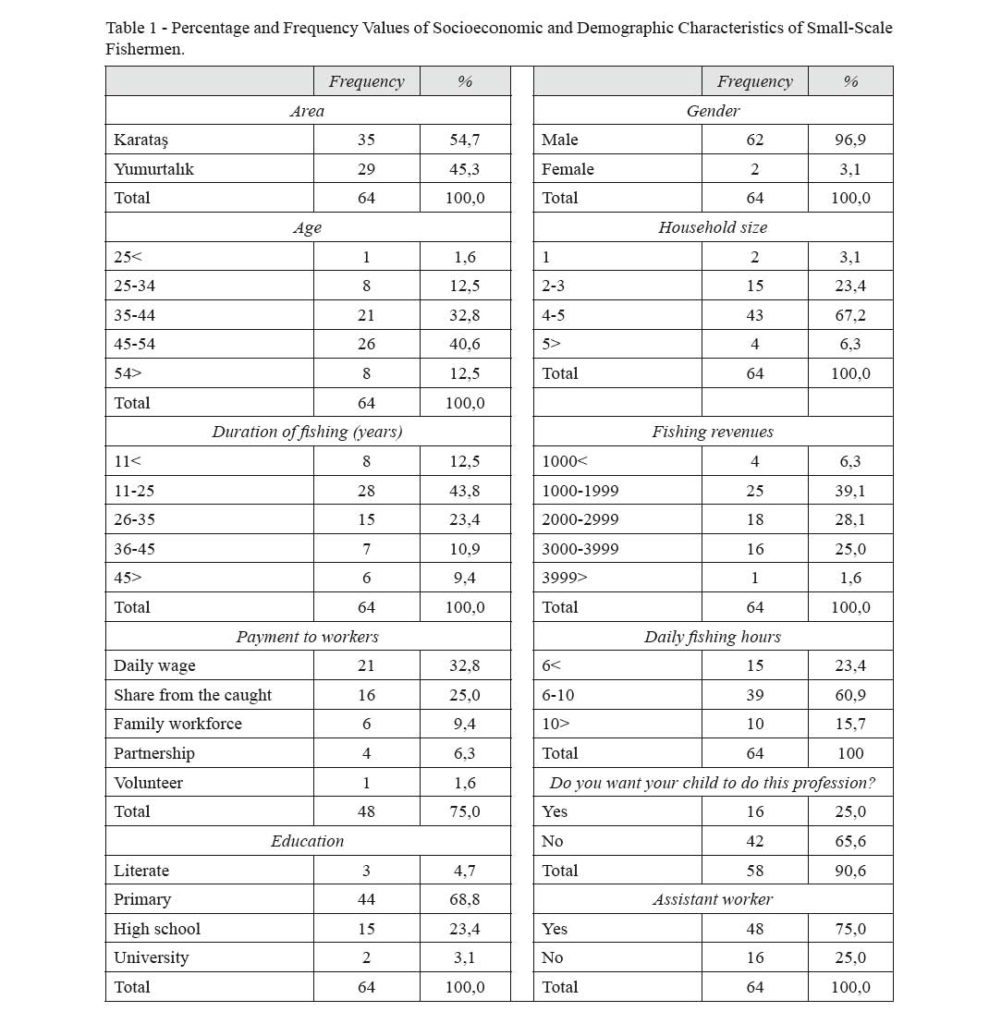
When Table 1 is examined, it is seen that almost all of the fishers are males (97%), significant portion with house hold size 4-5 individuals (67.2%) and most of them are between 35-55 years old (73.4%). The education level of focused fishermen is very low (73.5% at primary school level or lover), they are engaged in fishing activity for a long time (mostly more than 11 years) and spend average 6-10 hours a day on this activity. The majority of focus group fishermen employ assistant workers and giving them daily wages or a share from the caught. The vast majority of fishermen do not want their children to do this profession.
Descriptive data of inputs (maintenance and repair costs, operational costs like fuel, ice, feed, food and labor costs) and production values (value of captured fish and other seafood) used for efficiency analysis for small-scale fishermen surveyed in the study are given in Table 2.
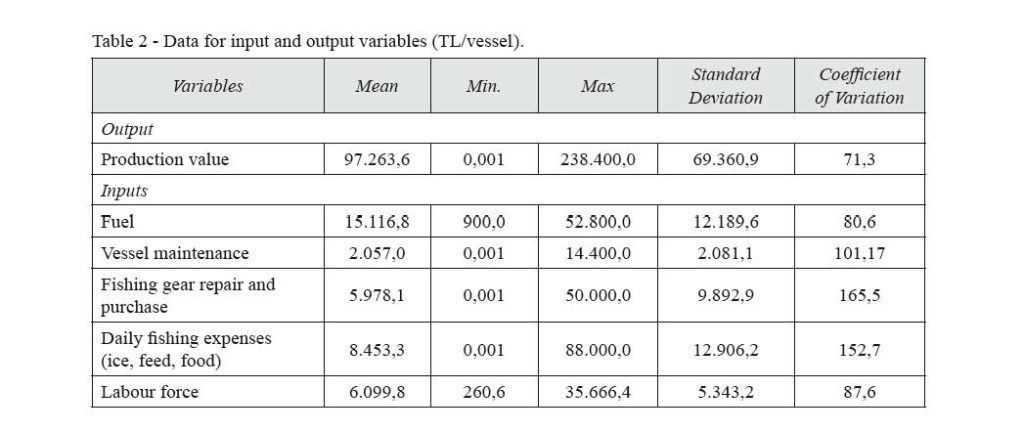
In Table 2, while annual average production value of fishing per vessel is calculated as 97,263 Turkish Lira (TL), annual average input usage per vessel calculated as 37.705 TL. Within these expanses small-scaled fishers spends 15,116 TL for fuel, 2,057 TL for boat maintenance, 5,978 TL for fishing gear repair and purchase, 8.453 TL for daily fishing expenses (feed, ice and food) and 6,099 TL for labor force. When the variation coefficients of the variables are examined, it is understood that the expenditures for fishing gears (maintenance and purchase) and hunting costs (ice, feed, food, etc.) have the highest values. This situation indicates that the fishing process is not properly managed and that inputs are not used correctly.
Findings from the data envelopment analysis for the efficiency status of fishing performances of small-scale fishermen are given in Table 3.
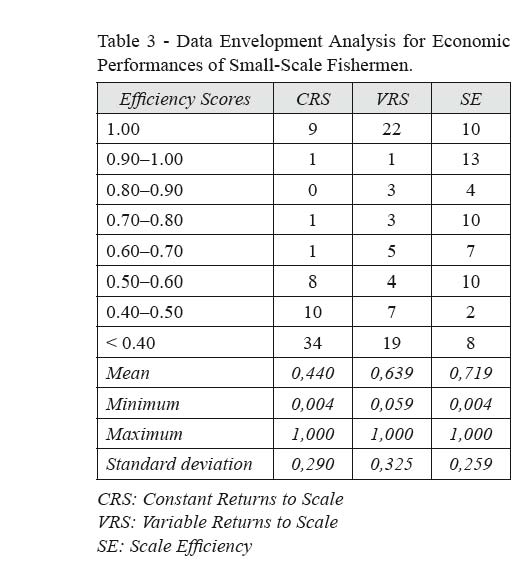
According to the input-based DEA results (Table 3), the average economic efficiency of fishermen under constant returns to scale (CRS) is 0.44 while the average economic efficiency under variable returns to scale (VRS) is 0.64. In addition, the scale efficiency (SE) is determined as 0.72.
When the frequency distributions of the scores obtained from the DEA analysis for the inputs were examined, it was determined that the number of full efficient fishermen under the variable returns to scale (VRS) is 22, while the number of fishermen with fully efficiency under constant returns to scale (CRS) is 9. However, the number of scale efficient (SE) fishermen is 10. Under the CRS conditions, the number of fishing vessels under 0.40 activity score is 34, while under VRS conditions the vessel number is 19 and under SE conditions, 8. The number of fishing vessels with the activity score in the range of 0.40-0.60 is 18 under CRS, 11 under VRS and 12 under SE. These results suggest that fishermen can use inputs more efficient in the fishing activities, by increasing the efficiency of resource use. It seems possible that if fishermen reduce their input usage by average of 36.1%, they can achieve the same fishing performance. In addition, it is determined from the survey that 42% of the fishermen (27) are in the increasing return to scale position, other 27 of them are in the decreasing return to scale position and only 10 (16%) were in the fully efficiency limit.
When fishing activities are examined, it has been determined that the main factors bring inefficiency are size of the fishing vessels and the low catching scale of these vessels. On the other hand, fishermen are not able to provide the appropriate input composition and this causes inefficient use of inputs. Excessive input use of small-scale fisheries is given in Table 4.
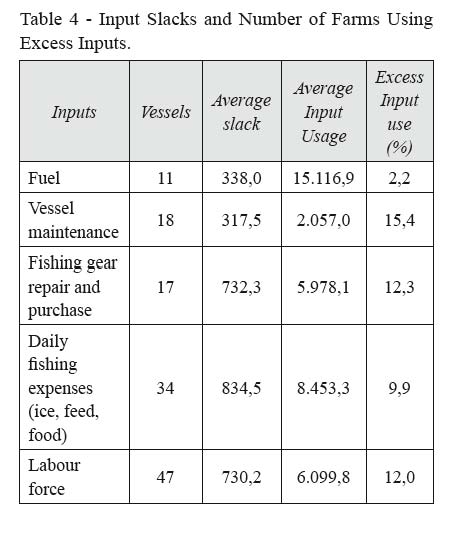
According to the results of the input use analysis (Table 4), it is obtained that the most ineffective source in terms of fishing performance is vessel maintenance expenditures (15.4%). Besides, other important sources of ineffectiveness are expenditures on repair and purchase of fishing gears (12.3%) and the labor force (12.0%). It was also found that there is excessive input use in daily fishing expenses like feed, food, ice, by 9.9% and fuel by 2.2%, respectively.
The long-term and excessive use of fishing vessels and fishing gear used by small-scale fishermen necessitates a significant share of their maintenance, repair and purchase, which causes inefficiency. In addition, the high level of family labor utilization and the low level of education of the workers lead to ineffective use of labor force.
3.1. Determinants of Economic Efficiency
In order to determine the source of inefficiency in the performance of small-scale fishermen, regression analysis was performed between the efficacy scores obtained as a result of DEA analyzes on variable-scale return conditions and the various socio-economic and demographic characteristics of fishermen. In this context, a two-tailed Tobit model was used when the efficiency scores were between 0 and 1 (Ray, 2004). The results of the analysis are given in Table 5.
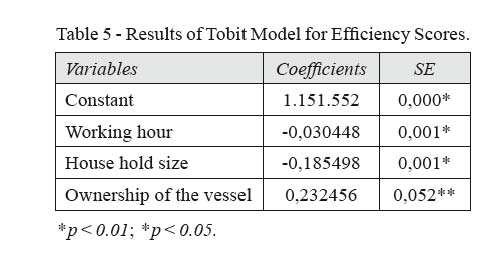
When the relationship between the efficiency scores obtained from the data envelopment analysis and the socio-economic and demographic structures of the fishermen was analyzed with the help of Tobit analysis, statistically significant results were obtained for the household size, working hours and ownership status of the fishing vessels. According to the findings obtained from Tobit analysis (Table 5), there is a negative and significant relationship between household size and activity of fishermen (p < 0.01). This leads to the fact that the increase in household size leads to a negative effect on the efficiency of fishing activities.
It was also found that there was a opposite and significant relationship between daily working hours of small-scale fishermen and hunting performance activity (p < 0.01). The increase of working hours causes adverse effect on hunting performance and the variation of hunting hours also increases this negative effect. This indicates that fishermen cannot use their active working time efficiently.
Moreover, there is a statistically significant and positive correlation between the vessel property status of small-scale fishermen (in case the property is in fishermen) and their fishing performance (p < 0.01). In this context, it has been revealed that fishermen who own the vessel have more efficiency in their fishing activities and that fishermen operating with other payment and utilization systems such as renting or leasing cannot use their resources economically effectively. It can be said that the creation of appropriate credit conditions for small-scale fishermen to have their vessels or to renew their existing vessels will have beneficial results in terms of regional fisheries.
4. Discussion and Conclusions
Small-scale coastal fisheries, which generally concentrate in rural coastal areas of developing countries where tourism and industry activities are limited, have considerable economic, sociological and environmental impacts. Small-scale fishing is a key livelihood strategy in coastal and rural communities, plays an important role in food security and poverty alleviation and represent the largest part of the population involved in the fishery sector and businesses are generally family-based as the boat owner goes at sea with other members of the family (Naji, 2013; Mulazzani et al., 2017). In addition, the fact that it is an artisanal technique and that the destructive environmental effects are less than the larger-scale commercial fisheries have also increased the interest in small-scale fisheries in recent years. Small-scale fishermen, however, are prone to very high levels of vulnerability, which are closely related to their fishing activity and the type of livelihoods associated with it. This vulnerability affects them through various sources of risk (Béné et al., 2007).
The survey results show that the economic efficiency of fishery activities of small-scale fishermen is 0.64 and that the same performance can be achieved if the inputs are reduced by an average of 36.1%. The main factor causing this inefficiency is ineffectiveness of input usage. From past to present day, small-scale fisheries have often been presented as an activity characterized by low productivity and low yield rates (Béné et al., 2007). In Turkey, many small-scale fishing boats (60%) show negative economic performance. Therefore, for these vessels, profitability cannot be mentioned under the existing structure and they are not economically sustainable (Ünal, 2013).
When the inputs causing the inefficiency of the small-scale fishers were examined, it was determined that the biggest problem is on vessel maintenance expenses (15.4%) and fishing gear repair and purchase (12.3%). The fact that small-scale fishermen operate in restricted areas with low production capacity, addressing small local markets, having problems in providing credits, and lack of effective cooperative activities make them unable to operate with modern and new fishing gear and vessels. The fact that the fisheries sector has active cooperatives for small-scale fishermen should be considered as the most effective solution for input purchase, use and marketing of output.
Another significant inefficiency source for input use is the use of labor force (12%). In developing countries like Turkey, finding and using the qualification workforce in agriculture and fisheries activities is one of the common problems. The weaknesses in the economic strength of the sectors and the difficulty of the conditions constitute the main causes of this problem. The excess use of family labor without specializing in small-scale fisheries leads inefficiency. In this regard, it is necessary to implement vocational training in the field of fisheries and to strengthen the social security situation of small-scale fishermen. It has also been found that ineffectiveness is also a concern in the use of feedstuffs, ice and feedstocks for fishing. The lack of a systematic use of these inputs leads to this result. A relatively ineffective state has also been identified in fuel use.
The relationship between vessel size and fishing activity performance shows that small scale coastal fishing activities has a disadvantage compared to large-scale deep-water fishery.
The relationships between socio-economic structures and fishery performances of small-scale fishermen participating in the survey were examined and the statistical significance of the household width, the number of working hours and the boat ownership factors were determined. Thus, the increase in household size leads to an increase in the use of unpaid family labor, which is common in small-scale fishermen, and this leads to the use of excessive family labor that does not have specialization.
Negative impacts of increased working hours on fishery performance indicate that fishers have problems with lack of motivation and effective use of time in fishing activities. The survey also found that fishermen having their own vessels make a positive effect on fishing performances. In this context, it can be said that the creation of suitable credit conditions for small-sized fishermen to have their vessels or to renew their existing vessels will have beneficial results in terms of regional fisheries. However, the lack of sufficient competences in the mortgage and solvency issues make it very difficult for small-scale coastal fishermen to use credit. Provision of low-interest long-term credit facilities in the form of rural development loans or projects for small-scale fishermen to be boat owners may be the solution to this problem.
On the other hand, small-scale fishermen were found to be in a disadvantageous position due to scale differences compared to large-scale fishermen. Therefore, it is necessary to take measures to increase the competitiveness of small-scale fishermen and to take this into consideration in supporting the sector. The costs to make use of the supports are due to additional financial costs and excessive bureaucratic procedures preventing coastal fishermen from taking full advantage of these supports.
Acknowledgements
This research was derived from the FBA-2016-2649 project, which was supported by the Scientific Research Projects Unit of the University of Çukurova, Turkey.
References
- Allison E.H., 2011. Aquaculture, fisheries, poverty and food security. World fish center working paper, 65: 62.
- Alemdar T., Işık H., 2008. Technical Efficiency of Peanut Growing Farms in Turkey. Acta Sci. Pol. Oeconomia, 7(4): 5-15.
- Béné C., Macfadyen G., Allison E.H., 2007. Increasing the contribution of small-scale fisheries to poverty alleviation and food security, FAO Fisheries Technical Paper, Rome, FAO, 481: 125.
- Ceyhan V., 2017. Production efficiency of Turkish beekeepers and its determinants. Custos e Agronegócio online, 13(3).
- Ceyhan V., Gene H., 2014. Productive efficiency of commercial fishing: Evidence from the Samsun province of Black Sea, Turkey. Turkish Journal of Fisheries and Aquatic Sciences, v. 14.
- Charnes A., Cooper W.W., Rhodes, E., 1978. Measuring the efficiency of decision making units. European Journal of Operational Research, 2(4): 429-444.
- Coelli T.J., Rao D.S.P., Battese G.E., 2005. An introduction to efficiency and productivity analysis. USA: Springer.
- FAO, 2015. First regional symposium on Sustainable small-scale fisheries in the Mediterranean and Black Sea. Edited by Srour A., Ferri N., Bourdenet D., Fezzardi D., Nastasi A., Rome: FAO. FAO Fisheries and Aquaculture Proceedings, 39.
- Farrell M.J., 1957. The Measurement of Productive Efficiency. Journal of the Royal Statistical Society, 120(3): 253-290.
- Farrugio H., 2013. Current situation of small-scale fisheries in the Mediterranean and Black Sea: Strategies and methodologies for an effective analysis of the sector, thematic session 1, First Regional Symposium on Sustainable Small-Scale Fisheries in The Mediterranean and the Black Sea, St. Julian’s, Malta, 27-30.
- Guyadera O., Berthoub P., Koutsikopoulosc C., Alband F., Demanècheb S., Gaspare M.B., Eschbaumf R., Fahyg E., Tullyh O., Reynali L., Curtild O., Frangoudesd K., Maynoui F., 2012. Small scale fisheries in Europe: A comparative analysis based on a selection of case studies. Fisheries Research, 140: 1-13.
- Malorgio G., Mulazzani L., Pugliese P., Rota C., Zanasi C., Zuccaro M., 2017. The role of small-scale fisheries in Mediterranean coastal communities. An analytical framework for their development. New Medit, 17(2): 19-26.
- Mauthea M.B., Olesona K.L.L., Zafindrasilivonona B., 2013. The total economic value of small-scale fisheries with a characterization of post-landing trends: An application in Madagascar with global relevance. Fisheries Research, 147: 175-185.
- Mulazzani L., Zanasi C., Errico A., Pugliese P., Zuccaro M., Zerrouki R., Medani M., Ouazzani Tnacheri M., Mohanna C., Hamza H., 2017. The comparative analysis of Mediterranean coastal communities: case studies. New Medit, 16(2): 27-37.
- Naji M., 2013. Enhancing small-scale fisheries value chains in the Mediterranean and Black Sea, Thematic session IV-part 1, First Regional Symposium on Sustainable Small-Scale Fisheries in the Mediterranean and the Black Sea, St. Julian’s, Malta.
- Ray S.C., 2004. Data envelopment analysis: Theory and techniques for economics and operations research. New York: Cambridge University Press.
- Sudarmo A.P., Baskoro M.S., Wiryawan B., Wiyono E.S., Monintja D.R., 2015. Social economics characteristics of coastal small-scale fisheries in Tegal city. International Journal of Scientific & Technology Research, 4(1).
- Sauzade D., Rousset N., 2013. Greening the Mediterranean fisheries: Tentative assessment of the economic leeway, Technical Report, Plan Bleu, Valbonne.
- Toloo M., Nalchigar S., 2009. A New integrated DEA model for finding most BCC-efficient DMU. Applied Mathematical Modelling, 33: 597-604.
- Ünal V., 2003. Yarı zamanlı küçük ölçekli balıkçılığın sosyo-ekonomik analizi, Foça (Ege denizi). E.U. Journal of Fisheries & Aquatic Sciences, 20(1-2): 165-172.











